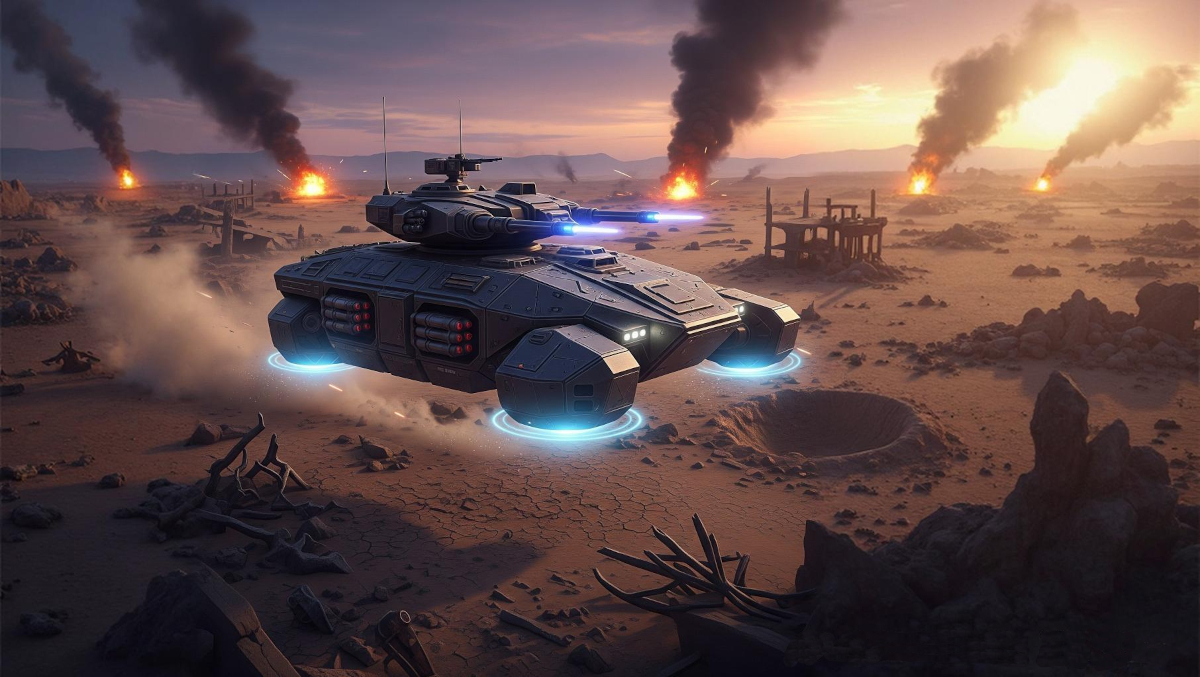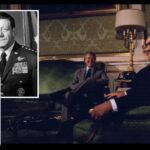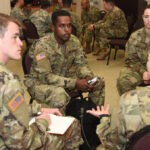
The Force XXI concept envisioned an adaptable and responsive Army defined by five core characteristics.
They got it right—thirty years ago the authors of TRADOC Pamphlet 525-5: Force XXI Operations: A Concept for the Evolution of Full-Dimension Operations for the Strategic Army of the Early Twenty-First Century visualized the operational environment of the first quarter of the century, at least the effect of technology. Even with the information age in its infancy, there was a premonition that something big was on the horizon. Technological innovations, they said, “are harbingers of change in warfare” and “will revolutionize—and indeed have begun to revolutionize—how nations, organizations and people interact.” The 1994 Force XXI concept defined the Army characteristics (attributes) that drove force and capability design through the first quarter of the twenty-first century. Leaning into the next quarter century, the Army should re-visualize the operational environment and craft a new set of army characteristics for 2040.
The Force XXI concept envisioned an adaptable and responsive Army defined by five core characteristics. It emphasized doctrinal flexibility and strategic mobility, ensuring the right forces were available when and where needed. Central to this vision were tailorability and modularity—deploying only necessary forces for optimal efficiency—alongside connectivity, prioritizing seamless joint, multinational, and interagency collaboration. Finally, Force XXI stressed versatility, requiring forces prepared for both conventional warfare and military operations other than war (MOOTW) (a term which has transitioned to irregular warfare today).
The Vision, the Reality, and the Delta
The Force XXI concept rightly identified key characteristics for a future Army—adaptability, responsiveness, and a focus on maneuver warfare—but its vision vastly underestimated the transformative power of the impending digital revolution.
Given that the authors of the Force XXI concept envisioned a thousand-fold advance in information technology over the ensuing two decades (and may have actually been off by a magnitude of a thousand), their five army characteristics seem remarkably absent of any consideration of information technology. While anticipating significant advances, the concept failed to fully integrate it into its core characteristics, focusing instead on adjustments to traditional army concepts.
Thirty years later, the Army finds itself in a strikingly similar situation. Emerging technologies once again redefine how we think about war. The Chief of Staff of the Army recently said that “the character of war is changing. It is changing rapidly because disruptive technology is fundamentally altering how humans interact.”
If the character of war is changing today, then the Army should carefully consider what the character of the 2040 Army will be. Legacy characteristics such as mobility and versatility have been useful over the past decades, but those characteristics focus on the physical domains, where any advantage is fleeting and asymmetric methods can counter. Integrating cognitive qualities such as awareness and knowledge into a description of the Army of 2040 will help the Army visualize itself over the coming decades.
Articulating the desired army characteristics will also help the Army guard against simply projecting a variant of the current force into the future and outfitting it with new equipment. This approach is not intellectually rigorous enough to fully explore how the Army of 2040 must operate—nor will it ensure the Army is prepared for the challenges of the future operational environment.
Though admittedly not an authoritative or exhaustive listing, the following six characteristics provide examples of broad thinking about the Army of 2040.
Continuously Learning—Continuously Aware
Building on lessons learned from the limited integration of information technology in Force XXI, the Army of 2040 must prioritize continuous learning and awareness. This concept is not just about gathering intelligence but about achieving domain awareness superiority across land, sea, air, space, and cyberspace. We are already seeing elements of this in conflicts like Ukraine, with drone reconnaissance feeding into battlefield management systems. However, the 2040 Army will move beyond data collection to synthesizing data into actionable knowledge in advance of need. This is what Chief Warrant Officer 4 Robert Ryder terms domain awareness superiority: “The future isn’t about seeing more; it’s about understanding what you see, predicting what’s coming, and acting before it happens.” This means anticipating enemy movements based on communication patterns, logistics, and even social media. This awareness must also be inward-looking, assessing our vulnerabilities and strengths—from supply chain issues to troop morale. The goal is a force that understands itself as deeply as it understands the enemy.
Predictive
Recognizing the need to move beyond reactive strategies—a challenge highlighted by the Force XXI experience—the Army of 2040 must prioritize prediction. The future battlefield will reward those who can anticipate, moving beyond the traditional observe-orient-decide-act (OODA) loop to a “predict-act” vector. This notion requires integrating autonomous systems and continuous learning into decision-making. Think of AI-powered simulations that can model enemy behavior and predict the consequences of different courses of action. These simulations, embedded in weapons and command platforms, could allow commanders to proactively shape the environment and reduce adversary options, thereby minimizing the possible outcomes they have to deal with. For example, instead of reacting to a cyberattack, we could predict and preemptively defend it. This also requires advanced analytics at the tactical level, empowering small units to anticipate threats and adapt. The goal is to operate based on what will be, not just what is.
Unknowable (Hidden)
Addressing the vulnerability of predictable forces, a weakness exposed in recent conflicts and a shortfall of the Force XXI vision, the Army of 2040 must become “unknowable”—hidden from the adversary. Current conflicts demonstrate the vulnerability of predictable forces in open terrain. To counter this, the Army will embed deception capabilities at all echelons, utilizing advanced camouflage, electronic warfare, and disinformation that will actively complicate enemy targeting. This concept necessitates reducing our signature across all domains—physical, cyber, and electromagnetic—and constantly shifting operational patterns to avoid predictability and exploit the enemy’s reliance on established behaviors. Crucially, this extends to safeguarding personnel and family information and developing Army-sponsored programs to maintain their privacy and financial and information security. The current proliferation of servicemembers on private social media platforms and their mix of private and work-related posts will be more dangerous in 2040 and must be curtailed. Maintaining operational security will be paramount, demanding awareness and discipline throughout the force. Imagine units dynamically altering their electronic signature to mimic civilian traffic or deploying autonomous decoys—all contributing to an operational environment where the enemy struggles to gain a clear picture of the Army’s intent and actions.
We must create a credible posture that gives an adversary pause before initiating aggressive actions, forcing them to calculate the unacceptable costs and risks involved.
Compelling
Learning from the limitations of simply achieving battlefield dominance, the Army of 2040 must be compelling. The Army of 2040 must aim not only to defeat the enemy but also compel them to comply with our will. This notion requires understanding adversary vulnerabilities and shaping the environment for unacceptable outcomes. To paraphrase Clausewitz, war is about forcing the opponent to do what you want. Achieving this requires multi-domain overmatch at fracture points and leveraging capabilities across all domains—not simply demonstrating superiority but actively denying the adversary the ability to achieve their objectives. The Army will disrupt enemy infrastructure, cripple their networks, and demonstrate overwhelming force simultaneously. This combination could force negotiation on favorable terms. Deterrence will be essential, demonstrating the consequences of challenging U.S. interests and extending beyond simply threatening retaliation. We must create a credible posture that gives an adversary pause before initiating aggressive actions, forcing them to calculate the unacceptable costs and risks involved. Effective deterrence requires not only a visible and capable force, but also the demonstrated ability to rapidly and decisively respond to any provocation. Ultimately, the role of the Army is to compel—to shape the adversary’s decision-making process and ensure they act in accordance with our interests, even without resorting to large-scale conflict.
Adaptive
Recognizing the inherent unpredictability of future conflicts—a lesson reinforced by the evolving nature of warfare since Force XXI—the Army of 2040 must be adaptive. The operational environment of 2040 will be highly volatile, uncertain, complex, and ambiguous. This future requires continuous learning and self-healing systems, mitigating vulnerabilities in real time. It also demands multi-functional, cross-domain capable Soldiers and units able to operate seamlessly and adapt to changing missions. Maintaining a range of technology tiers will be vital—not simply having access to the most advanced systems, but also retaining proficiency with proven, reliable, and often lower-tech back-ups. This approach is not about clinging to obsolescence, but about recognizing that advanced technology can be vulnerable to countermeasures, jamming, or cyberattacks. A diverse toolkit allows us to degrade gracefully and maintain operational effectiveness even in contested environments. Furthermore, in certain scenarios—particularly those involving restrictive technology environments or sophisticated electronic warfare—an advantage can be gained by strategically “stepping back” in technology. Utilizing simpler, less detectable systems, or even reverting to analog methods, can circumvent advanced enemy sensors and maintain communication or operational capability. Think of units that can rapidly reconfigure, switch between offense and defense, and leverage both cutting-edge and legacy systems—a force that is not solely reliant on the latest advancements but can thrive in any technological landscape.
Decentralized
Acknowledging the vulnerability of centralized command structures in a contested environment, the Army of 2040 must be decentralized. Future adversaries will have systems capable of disrupting centralized command and control, necessitating forces capable of increased levels of distributed and independent action. Therefore, the Army of 2040 will be organized as highly dispersed organizations, capable of operating independently but designed to anticipate and converge effects and efforts to fracture adversaries. This concept would not abandon command and control (C2) but empower lower-level leaders to make decisions in degraded environments. Imagine small, autonomous units operating independently yet proactively coordinating their actions to achieve a synergistic impact—a network of capable teams able to adapt and overcome challenges without constant oversight. This network requires not only equipping soldiers to operate autonomously or semi-independently—creating an ‘autonomous soldier’—but also a continuous understanding and accounting for vulnerabilities and changes to C2 systems and processes. Critically, these units must be able to adapt to fractured command and control in degraded communications environments. Moreover, the Army must develop the ability to change C2 structures and task organization near-instantaneously, enabling rapid adaptation to evolving battlefield conditions and exploiting fleeting opportunities.
Conclusion
The Force XXI effort sought to prepare the Army for a future defined by technological superiority. While a valuable effort, it underscored a critical truth: anticipating the future of warfare solely through technological projection is insufficient. As the Army develops its next operating concept, there will likely be plenty written about what the Army does (missions) and what the Army has (capabilities or kit). As the senior army leaders did at the beginning of a revolution in military affairs (RMA) in 1994 when they published Force XXI Operations, it would be useful to frame what the Army is by explicitly describing the characteristics of the Army they are planning to build. Realizing this vision demands intellectual rigor. We must resist the simplistic temptation to solve today’s problems with tomorrow’s technology—seeking a “better howitzer” instead of asking: “What is better than a howitzer?” or even “Do we still need tanks?” Clearly articulating these characteristics is not merely an academic exercise; it defines what the Army will be, creating shared understanding and effort for the coming decades. Ultimately, the challenges of the second quarter of the twenty-first century demand a refreshed vision—a revitalized approach akin to Force XXI, but one grounded in fundamental transformation rather than incremental improvements. The time for that reimagining is now.
Sam White is the Deputy Director of the Center for Strategic Leadership at the U.S. Army War College.
The views expressed in this article are those of the author and do not necessarily reflect those of the U.S. Army War College, the U.S. Army, or the Department of Defense.
Photo Credit: Image generated by Gemini AI





I am curious if the US Army has considered the insights in this book?
Radical Uncertainty: Decision-Making Beyond the Numbers by John Kay, Mervyn A. King
I wonder whether the US Army has redesigned the acquisition cycle to be able to handle the rate of change in technology as seen in the Russia-Ukraine War.
I wonder whether the US Army has changed their formations to replicate the units Ukraine has created.
Here is the fifth paragraph of our article above:
“Thirty years later, the Army finds itself in a strikingly similar situation. Emerging technologies once again redefine how we think about war. The Chief of Staff of the Army recently said that “the character of war is changing. It is changing rapidly because disruptive technology is fundamentally altering how humans interact.”
If we consider that “creative destruction” is the overall and all-encompassing idea and term — within which such subordinate ideas and terms as “disruptive technology” and/or “disruptive innovation” are generally understood and discussed(?) — then, from that such perspective, should we consider the Army’s needs, today and on through and into the 2040s; these, (a) more from the perspective of the idea and term “creative destruction” and, thus, (b) more from the perspective of the classic problems commonly associated with same? In this regard, consider the matters presented below:
“Capitalism is the most successful wealth-creating economic system that the world has ever known; no other system, as the distinguished economist Joseph Schumpeter pointed out, has benefited ‘the common people’ as much. Capitalism, he observed, creates wealth through advancing continuously to every higher levels of productivity and technological sophistication; this process requires that the ‘old’ be destroyed before the ‘new’ can take over. … This process of ‘creative destruction,’ to use Schumpeter’s term, produces many winners but also many losers, at least in the short term, and poses a serious threat to traditional social values, beliefs, and institutions.” (From the very first page, of the very first chapter [the Introduction chapter] of the book “The Challenge of the Global Capitalism: The World Economy in the 21st Century” by Robert Gilpin).
“In any case, the argument for capitalism was based on long-term collective interest, an argument with little appeal to those left unemployed by the process of ‘creative destruction’ so central to capitalism, as entrepreneurial innovation led to the obsolescence of existing forms of production and those employed in them.” (From the book “The Mind and the Market: Capitalism in Western Thought,” by Jerry Z. Miller, in the section therein on Joseph Schumpeter.)
“All in all, the 1980s and 1990s were a Hayekian moment, when his once untimely liberalism came to be seen as timely. The intensification of market competition, internally and within each nation, created a more innovative and dynamic brand of capitalism. That in turn gave rise to a new chorus of laments that, as we have seen, have recurred since the eighteenth century: Community was breaking down; traditional ways of life were being destroyed; identities were thrown into question; solidarity was being undermined; egoism unleashed; wealth made conspicuous amid new inequality; philistinism was triumphant.” (Also from the book “The Mind and the Market: Capitalism in Western Thought,” in this case, from the section therein on Friedrich Hayek)
Question — Based on the “Creative Destruction” Concept Addressed Above:
If “the character of war” describes how wars are fought, and if such ideas and terms as “creative destruction” can be applied to same, then from that such perspective, (a) what (Army things) have been, need to be and/or can be “destroyed” today and (b) what (Army things) have been, need to be and/or can be developed today — not necessarily to take their place — but, rather, simply to “win wars?”
(Thus, to make the idea and term “creative destruction” work for us?)
Here is the second paragraph of our article above:
“The Force XXI concept envisioned an adaptable and responsive Army defined by five core characteristics. It emphasized doctrinal flexibility and strategic mobility, ensuring the right forces were available when and where needed. Central to this vision were tailorability and modularity—deploying only necessary forces for optimal efficiency—alongside connectivity, prioritizing seamless joint, multinational, and interagency collaboration. Finally, Force XXI stressed versatility, requiring forces prepared for both conventional warfare and military operations other than war (MOOTW) (a term which has transitioned to irregular warfare today).
Question:
If, today and going forward into the 2040s, nuclear and conventional deterrence is our strategy but our opponents (those both there abroad and here at home) — specifically because of our such emphasis on nuclear and conventional deterrence — have decided that they will seek to achieve their objectives more via unconventional, irregular, hybrid and/or MOOTW means. (Example: China seeks to expand its influence, and to reshape the geopolitical landscape; this, without resorting to direct military confrontation),
Then, based exactly on those such circumstances, can someone “paint us a picture” of, exactly, what the U.S. Army — today and going forward into the 2040s — should look like?
This is a really thought-provoking deep dive into the Army of 2040! It’s so vital to be having these discussions now about moving purposefully beyond the “Big 5” procurement focus to embrace the interconnected, data-driven “Big Digital” future, while also preparing for that broader, more uncertain spectrum of global conflict. Thanks for clearly outlining what will be required.
It sparks a couple of questions for me though: What are some of your thoughts on the specific cultural shifts within smaller units and leadership training that would best foster decentralized decision-making in a multi-domain, data-rich threat environment?
Also, considering the rapid pace of technological innovation, how do you see the Army navigating the balance between highly advanced digital capabilities and the ongoing need for robust, resilient forces that can operate effectively in genuinely low-tech, contested landscapes? There’s definitely a lot to unpack!
Nice work, Sam. I think the link to XXI doctrine/thoughts is incredibly useful. The real question is how we overcome cultural and bureaucratic obstacles to making this vision real.
An actionable 2040 US Army, where all war processes are automated.